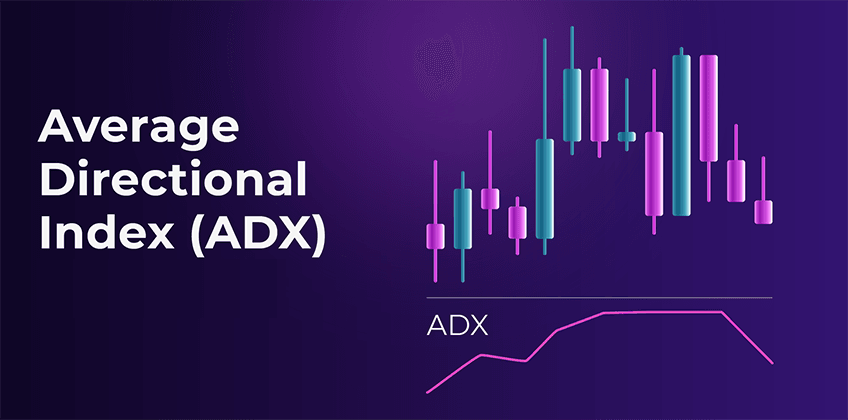The Average Directional Index (ADX) is a popular technical analysis tool used by traders to measure the strength of a trend in financial markets. Unlike other indicators that focus on the direction of price movement, ADX helps to determine whether a market is trending or ranging, offering valuable insights into market momentum.
By measuring the momentum of price movements, the ADX enables traders to identify potential entry and exit points, enhancing their overall trading strategies. In this article, you will explore the fundamentals of the ADX, its calculation, interpretation, and its advantages and disadvantages.
What is the Average Directional Index Indicator (ADX)?
The Average Directional Index (ADX) is a widely used tool in technical analysis, developed by J. Welles Wilder, to help traders assess the strength of a market trend. It indicates whether a market is trending and measures the trend’s intensity. The ADX value ranges from 0 to 100, with higher values signifying a stronger trend.
The ADX does not indicate the direction of the trend but rather its strength, making it valuable for traders to locate trading opportunities and low volatility. By combining the ADX with other indicators, traders can gain a more comprehensive understanding of market conditions and make more informed trading decisions.
How Does the Average Directional Index Indicator Work?
ADX measures the strength and momentum of a trend, regardless of its direction. It includes three lines: the ADX line, the Positive Directional Indicator (+DI), and the Negative Directional Indicator (-DI). The ADX line shows the trend’s strength, while the +DI and -DI lines indicate the trend’s direction. An ADX value above 25 suggests a strong trend, while a value below 20 indicates a weak or non-existent trend.
Formula and Calculation of Average Directional Index Indicator
The Average Directional Index (ADX) can be calculated using the following formula:
ADX = {100 × (Exponential moving average of the absolute value of (+DI – -DI))} / ((+DI + -DI))
Step-by-Step Process to Calculate ADX
- Calculate +DI (Positive Directional Indicator):
- Find the difference between the current high and the previous high.
- If positive, add to +DI; if negative, set +DI to 0.
- Calculate -DI (Negative Directional Indicator)
- Find the difference between the current low and the previous low.
- If positive, set -DI to 0; if negative, add to -DI.
- Average +DI and -DI
- Add +DI and -DI together.
- Divide the sum by 2.
- Calculate the absolute value of +DI and -DI
- Find the absolute value of +DI – -DI.
- Average |+DI – -DI| and +DI + -DI
- Add |+DI – -DI| and +DI + -DI together.
- Divide the sum by 2.
- Multiply by 100
Example
- Previous High: 50
- Previous Low: 45
- Current High: 55
- Current Low: 48
1. Calculate +DI
- Difference between current high and previous high: ( 55 – 50 = 5 )
- Since the difference is positive, +DI = 5
2. Calculate -DI
- Difference between current low and previous low: ( 45 – 48 = -3 )
- Since the difference is negative, -DI = 3
3. Average +DI and -DI
- Sum of +DI and -DI: ( 5 + 3 = 8 )
- Average: 8/2 = 4
4. Calculate the absolute value of +DI – -DI: Absolute value: ( |5 – 3| = 2 )
5. Average |+DI – -DI| and +DI + -DI:
Sum: ( 2 + 8 = 10 )
Average: {10/2 = 5
5. Multiply by 100: 5*100 = 500
So, the ADX value in this example is 500.
Interpretation of Trend Momentum With ADX
The Average Directional Index (ADX) is a well-known technical measure that is used to figure out how strong a market trend is. The Positive Directional Indicator (+DI) and the Negative Directional Indicator (-DI) are two other signs that are often used with it. When traders know how to read the ADX, they can tell if a market is rising or ranging, which helps them make better trading choices.
To figure out how to read trend motion with ADX, think about the following:
- When ADX is above 25: There is a strong trend. When ADX goes up, the trend gets stronger.
- Values of ADX Below 25: A weak trend is present. The trend gets weaker as the ADX number goes down.
- When the ADX value goes up: the action picks up speed.
- When the ADX value goes down: the action loses speed.
Advantages and Disadvantages of Average Directional Index Indicator (ADX)
Below is a detailed table outlining the advantages and disadvantages of the average directional index (ADX) indicator:
| Advantages | Disadvantages |
| Identifies trend strength and potential reversals | May produce false signals, leading to potential losses |
| Useful for entry and exit points in trades | Lags behind price action, sometimes too late to act |
| Detects overbought or oversold market conditions | Limited information on market and trend duration |
| Simple interpretation with values from 0 to 100 | Requires an established trend to generate signals |
Conclusion
The average Directional Index (ADX) is a powerful indicator for traders seeking to assess the strength of a trend. By understanding and incorporating ADX into your trading strategy, you can make more informed decisions about whether the market is trending strongly or moving sideways.
While ADX doesn’t indicate the direction of the trend, its ability to measure momentum makes it a valuable addition to any trader’s toolkit. Used in combination with other indicators, ADX can enhance your overall trading success and risk management.
Frequently Asked Questions
Q1. What if ADX is below 20?
An ADX value below 20 indicates a weak trend or a ranging market, suggesting that the price is moving sideways without a clear direction.
Q2. Is ADX and RSI same?
ADX measures trend strength, while RSI (Relative Strength Index) measures momentum and identifies overbought or oversold conditions. They serve different purposes in technical analysis.
Q3. Is ADX the best indicator?
ADX is a valuable indicator for assessing trend strength, but no single indicator is the best. Combining ADX with other indicators like RSI or moving averages can provide a more comprehensive analysis.










